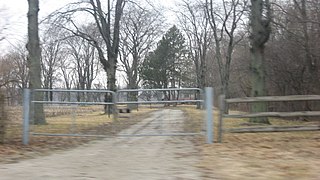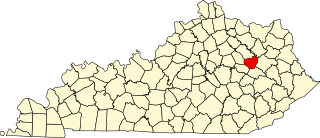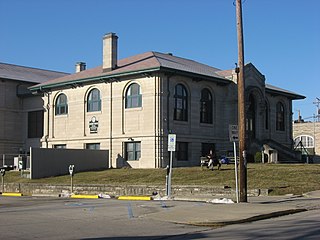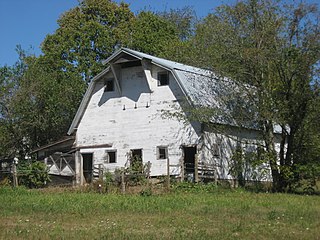
This is a list of properties and districts in Indiana that are listed on the National Register of Historic Places. There are over 1,900 in total. Of these, 39 are National Historic Landmarks. Each of Indiana's 92 counties has at least two listings.

The Rookery Mound is an archaeological site near Everglades City, Florida. On November 5, 1996, it was added to the U.S. National Register of Historic Places.

The Rock Mound Archeological Site is an archaeological site in Key Largo, Florida. It is located a half mile west of U.S. 1. On July 1, 1975, it was added to the U.S. National Register of Historic Places.

The Waddells Mill Pond Site is an archaeological site located seven miles northwest of Marianna, Florida. On December 15, 1972, it was added to the U.S. National Register of Historic Places.

The table below includes sites listed on the National Register of Historic Places (NRHP) in Jefferson County, Kentucky except those in the following neighborhoods/districts of Louisville: Anchorage, Downtown, The Highlands, Old Louisville, Portland and the West End. Links to tables of listings in these other areas are provided below.

The Conrad Mound Archeological Site is an archaeological site in the southwestern part of the U.S. state of Ohio. Located east of Cleves in Hamilton County, the site is centered on an isolated Native American mound. Its location atop a ridgeline has been interpreted as evidence that the mound was constructed by the Adena culture. No artifacts have been found at the site, for no archaeological excavation has ever been carried out; however, experience with other sites has led archaeologists to surmise that the mound is surrounded by a larger zone of archaeological interest. Because of its potential archaeological value, the mound was listed on the National Register of Historic Places in 1975.

The Williamson Mound Archeological District is an archaeological site in the southwestern part of the U.S. state of Ohio. Located north of Maud in Butler County, the mound appears to have been the work of peoples of the Hopewell tradition.
Nottingham is a small town on the Patuxent River in Prince George's County, Maryland, United States. It contains an archaeological site which was listed on the National Register of Historic Places in 1975.

This is a list of the National Register of Historic Places listings in Butler County, Kentucky.

This is a list of the National Register of Historic Places listings in Fulton County, Kentucky.

This is a list of the National Register of Historic Places listings in Logan County, Kentucky.

The Dodge Site is an archaeological site in the northwestern part of the U.S. state of Ohio. Located north of Bowling Green in Wood County, the site was inhabited by Middle Woodland and Upper Mississippian peoples. Among the artifacts discovered at the site are ceramics and stone tools. The site's stratigraphy is obvious: the Middle Woodland village site and cemetery can easily be distinguished from the Upper Mississippian occupation zone that sits on top of it. While only a small portion of the 2.2 acre (0.89 ha) site has been excavated, the artifacts that have been discovered at Dodge have contributed significantly to an understanding of the western basin of Lake Erie around AD 1300. Enough material has been recovered to facilitate radiometric dating, as well as identifying the peoples who once inhabited the site. The excavations also revealed the intensity of occupation: the Middle Woodland layer was substantially larger than the exceptionally thin Upper Mississippian component.

Epsilon II is a significant archaeological site on the shores of Lake Monroe in southeastern Monroe County, Indiana, United States. One of the largest preserved sites from its time period in the region, it has been designated a historic site.

This is a list of the National Register of Historic Places listings in Bath County, Kentucky.

This is a list of the National Register of Historic Places listings in Menifee County, Kentucky.

James Monroe Family Home Site, also known as James Monroe's Birthplace, is a historic archaeological site located near Oak Grove and Colonial Beach, Westmoreland County, Virginia. The site includes the ruins of the Monroe Family Home and birthplace of President James Monroe, which were uncovered in 1976 by a team from the College of William & Mary. Monroe spent his entire youth working the farm until he left for his education at William & Mary, following which he served in the Continental Army. The archaeological team uncovered a house foundation measuring 20 feet by 58 feet. The known 1845 etchings of the birth home indicate a small four room, rough cut wooden farm house with few outbuildings on a 500-acre farm filled with wetlands.

The Lunsford-Pulcher Archeological Site is a prehistoric archaeological site in rural Monroe and St. Clair counties in Illinois. The site was the location of a Middle Mississippian village which was probably a satellite community of Cahokia. Several pyramidal burial mounds are included in the site. Archaeological excavations at the site have also discovered the remains of houses and garden beds, making the site one of the few Mississippian villages at which garden beds have been found. The site has been known to European settlers since early settlement of the area in the late 18th century; despite being used for farmland, the site remains in good condition.

The Larson Site is a prehistoric archaeological site in Fulton County, Illinois, near the city of Lewistown. The site was the location of a Mississippian town and was occupied during the 13th and 14th centuries. The town was one of seven major town sites in the central Illinois River valley and served as a social and economic center for surrounding villages and farms. The artifacts uncovered at the site have been well-preserved and include both organic remains and intact homes, providing significant archaeological evidence regarding the Mississippian way of life.

Monroe Carnegie Library, also known as Old Monroe Carnegie Library, is a historic Carnegie library located at Bloomington, Monroe County, Indiana. It was built in 1917, and is a one-story, rectangular, Neoclassical style limestone building on a raised basement. The Monroe County History Center is a history museum the historic library building that was established as a Carnegie library. The museum is located on the site of Center School in the former Bloomington Public Library building. The library building is now home to the Monroe County Historical Society, their collection of artifacts, and their Genealogy Library. A historical marker is present at the site. The History Center is located at 202 East 6th Street. It is a tourist attraction.

Maple Grove Road Rural Historic District is a national historic district located in Bloomington Township and Richland Township, Monroe County, Indiana. The district encompasses 69 contributing buildings, 7 contributing sites, 8 contributing structures, and 30 contributing objects in a rural area near Bloomington. The district developed between about 1828 and 1950, and include notable examples of Gothic Revival and Greek Revival style architecture. The contributing elements are located on 12 farmsteads. Located in the district is the separately listed Daniel Stout House.






















